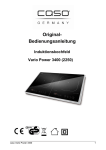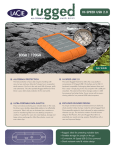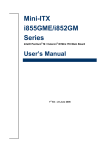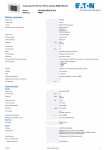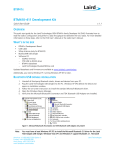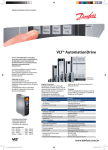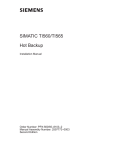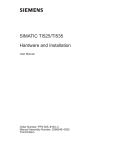Download ICS Regent®
Transcript
ICS Regent ® PD-6002 Communications Modules RS-232, RS-422 and RS-485 (T3150A) Issue 1, March, 06 Communications modules provide a serial communications interface between the controller and external equipment. Communications modules are commonly used to connect the controller to the computer running the WINTERPRET application, serial printers, man-machine interfaces, distributed control system gateways, and other peer-to-peer controllers. Features · Two isolated serial ports per module. · Supports RS-232, RS-422 and RS-485 standards. • Regent R2, Guarded Peer-Link, and Modbus protocols. · Front panel indicators on each module show communications status and transmit/receive activity. · TÜV certified for safety, Risk Class 5. Module Operation A block diagram of a typical communications module is shown in Figure 1. Communications modules are serial receiver-transmitters that provide an electrical interface for RS-232, RS-422, and RS-485 communications equipment. Each communications module receives power from all three of the processor modules. A power-sharing circuit in each of the communications modules receives the power from the three Industrial Control Services 1 Communications Modules (T3150A) processor modules and combines it through a diode OR powersharing circuit. This ensures that if one processor module's power supply fails, the communications module will continue to operate by drawing power from the two remaining power supplies, and the system's communications functions are maintained. Additional isolated power converters provide isolated power to the two serial ports. This isolation provides protection from external communications cable signal noise and grounding from affecting module operations. Figure 1. Block Diagram of Communications Module. The Dual UART (universal asynchronous receiver/transmitter) buffers incoming and outgoing communications characters. The triplicated processor modules interrupt once 2 Industrial Control Services Communications Modules (T3150A) every millisecond to read characters from or write characters to the communications module. When the processor modules read characters from the communications module, the communications module sends characters through triplicated bus drivers to the processor Safetybus. The processor modules vote this triplicated data and perform communications processing. When the processor modules write data to the communications module, the triplicated data is voted by the communications modules and sent to the dual UART where it is then transmitted out the associated port. The communications modules’ two serial ports operate independently and can both be configured differently. Electrical configuration is done by changing jumper settings to select point-to-point or multidrop configurations. The ports can be used to support a wide variety of functions including Regent R2 protocol, Modbus protocol, ASCII output, and Guarded Peer-Link communications. The WINTERPRET application is used to configure the appropriate port functions and specify baud rate, data format, parity, and node number. Testing and Diagnostics The modules triplicated Safetybus interface ensures that no failure in the module will effect the operation of the Regent system or other module. Extensive fault detection and annunciation of critical redundant circuits helps ensure that processors will not accept erroneous data from a faulty module. Each type of communications module has a unique identification code that is read by the controller. This code lets the controller know what type of module is installed in each communications slot. If a module is removed and replaced with a module of a different type the processors will indicate a COMM error. The processor modules perform background diagnostic checks on the module to test bus driver circuits and check the communications module ID codes. Communications message format, framing, checksum, and other communications errors PD-6002 Mar-06 3 Communications Modules (T3150A) are checked by the processor modules’ normal communications processing. Failures result in a COMM module error indication at the processor modules and a COMM error at the communications module. Front Panel Figure 2 shows the physical features of the communications modules. The front panel of each module contains indicators showing overall module health, and the transmit and receive status of each channel. In addition to the front panel indicators, each communications module has two DB-25 connectors (female). COMM Indicator This red and green LED pair indicates the overall health of the module. During normal operation the green LED is on. If a communications module fault is detected, the red LED turns on and the green LED turns off. Transmit/Receive Indicators These green LEDs are connected directly to the serial signal lines and flash while data are being transmitted or received. The TX LED flashes as data are sent from the module, and the RX LED flashes as data are received by the module. 4 Industrial Control Services Communications Modules (T3150A) Figure 2. Communications Module. PD-6002 Mar-06 5 Communications Modules (T3150A) Application Communications Port Connections Each communications port has a DB-25, female connector on the front of the module. The RS232 and RS422/485 signals are internally connected to the DB-25 connector pins as shown in Table 1. Refer to Figures 3 through 5 for recommended communications cable requirements and connections. Table 1. Communications Port Pin-out. Pin No. RS232 Signal RS422/485 Signal 2 TX (not used) 3 RX (not used) 7 GND GND 9 (not used) + 5 VDC 10 (not used) TX (-) 11 (not used) RX (-) 22 (not used) TX (+) 23 (not used) RX (+) Recommended Cable Type For multidrop and Guarded Peer-Link communications a Belden cable type 813x (where x = number of pairs) is recommended. The cable has the following characteristics that are important: 120 Ohm, Characteristic Impedance Twisted Pairs Overall shield Communications Configurations The communications module supports a variety of communications configurations which are shown in Figures 3 through 5. Figure 3 illustrates two point-to-point 6 Industrial Control Services Communications Modules (T3150A) configurations, one using RS232 connections for short distances and the other using RS422 connections for longer distances. Figure 4 illustrates multidrop connections between 2 or more Regents and a PC or other communications device supporting Regent R2 or Modbus protocols. Figure 5 illustrates multidrop connections between 2 or more Regents using the Guarded Peer-Link protocol. Figure 3. Point-to-Point Communications. PD-6002 Mar-06 7 Communications Modules (T3150A) Figure 4. Multidrop Communications. 8 Industrial Control Services Communications Modules (T3150A) Figure 5. Guarded Peer-Link Communications. Protocols and Communications Functions The protocol and function supported for each port is configured using the Serial Ports command from the Project Editor’s Definitions menu in WINTERPRET. An example of the Serial Ports dialog is shown in Figure 6. PD-6002 Mar-06 9 Communications Modules (T3150A) Figure 6. WINTERPRET’s Serial Ports Configuration Dialog. The function and protocol for each type of port that you can select is briefly described below. For more information on using the Serial Ports command see Section 4, Working with Projects, in the Regent User’s Guide. Comm Supports the Regent R2 protocol for point-to-point communications between the Regent and the computer running the WINTERPRET application. Some third-party ManMachine-Interface (MMI) products and DCS gateways may also support point-to-point communications using the Regent R2 protocol. Multidrop Supports Regent R2 protocol for multidropped Regents connected to a PC running the WINTERPRET application (or other third-party supporting products and gateways). Ports configured for multidrop communications require a node number. ASCII Used by the Regent to transmit ASCII output messages to external serial equipment such as printers and VDUs. ASCII output messages are programmed using the ASCII output element in ladder logic function blocks. 10 Industrial Control Services Communications Modules (T3150A) Net Master/Net Slave Used by the Regent for Guarded Peer-Link communications to other multidrop Regents. These ports require a node number. Modbus Supports connection to external Modbus communications equipment that acts as a Modbus Master (the Regent is a Modbus Slave). A Modbus port supports the Modbus RTU protocol. Modbus ports can be used in point-to-point or multidrop configurations. These ports require a node number. Jumper Settings for Point-to-Point and Multidrop Communications Each port can be independently configured for point-to-point or multidrop connections. When shipped from the factory, jumpers on-board the communications module are set for point-to-point communications. These settings are appropriate when a single Regent is connected to a PC or other communications equipment. The port definition can be COMM, ASCII or Modbus (point-to-point) as described above. When the port definition is Multidrop, Net Master, Net Slave or Modbus (multidrop) then the jumper settings on the module must be changed. Changing Jumper Settings The jumper settings on the module are used to determine how the transmit lines of the serial ports are controlled and also determine if internal termination, pull-up and pull-down resistors are connected to the serial lines. Table 2 shows the proper jumper settings for point-to-point, multidrop (Regent R2 or Modbus) and Guarded Peer-Link communications. PD-6002 Mar-06 11 Communications Modules (T3150A) Table 2. Communication Module Jumper Settings. Note: n indicates jumper installed Point-toPoint Multidrop (Regent R2 or Modbus) Description Port 1 Port 2 End TX pair terminator E101 E201 n RX pair terminator E102 E202 TX (-) pull-up E111 E211 RX (-) pull-up E112 E212 TX (+) pull-down E121 E221 RX (+) pull-down E122 E222 Transmit control E131 E231 Transmit control E132 E232 Transmit control E133 E233 n Middle n Guarded PeerLink End n n n n n n n n n n n n n n n n n Termination, Pull-up and Pull-down Resistor Jumpers When the module is used for RS422 or RS485 communications, the jumper positions for the internal termination, pull-up and pull-down resistors must be considered. Each termination resistor connects an internal 120 Ohm resistor across a specific differential pair and the pull-up and pull-down resistors connect a 1K Ohm resistor between each signal line and +5V or Comm. These resistors should be connected only at the end nodes of the multidrop communication network. Nodes in the middle should not have these jumpers connected. Figure 7 identifies the signal lines, resistors and jumpers associated with each port. Only the transmit (TX+ and TX-) and receive (RX+ and RX-) signal pairs are shown. Other jumpers and resistors for signal pairs CTS, RTS, DTR and DSR are also located on the module but they are not used by serial communications for the Regent and their jumper positions are not important. Note: If desired, you can install the termination, pull-up and pulldown resisters external to the communications module at the ends of the multidrop network. In this case position the jumpers in each communications module for a “middle” 12 Middle Industrial Control Services Communications Modules (T3150A) Regent. With each communications module’s jumper settings the same, module replacement is simpler. A single spare module can replace any communications module without the need to position the jumpers specifically for “end” or “middle” Regents before replacement. Refer to the communications port pin numbers shown in Figure 7 to determine the proper external connection of the resistors. PD-6002 Mar-06 13 Communications Modules (T3150A) Figure 7. RS422/485 Internal Signal Resistors. To change the jumper settings the communications module must be removed from the controller chassis and disassembled. 14 Industrial Control Services Communications Modules (T3150A) Module Removal and Disassembly Using a small slotted screwdriver, loosen the retaining screw near the top of the communications module. Pull open both removal levers on the front of the module. The module will disengage from the controller chassis. When it is disengaged, carefully slide the module out of the controller chassis. With the module removed, use a #2 Phillips screwdriver to remove the two screws from the left side of the module. Remove the four Phillips screws from the right side of the module (see Figure 8). Remove only those screw indicated in Figure 8. Figure 8. Communications Module Disassembly. After removing the screws, separate the printed circuit board from it protective metal frame. PD-6002 Mar-06 15 Communications Modules (T3150A) Refer to Table 2 to identify the proper jumper settings for your application’s communications configuration. Position the jumpers as needed on the module. Figure 9 shows the locations of the jumpers on board the module. Note: When shipped from the factory, no jumpers are installed on E131, E132, E133, E231, E232 and E233. For multidrop configurations you will need two jumpers for each port (such as E131 and E133 for port 1). The default factory settings include jumpers positioned at E104, E106, E114, E116, E124, E126, E204, E206, E214, E216, E224, and E226. These jumpers connect termination, pull-up and pull-down resistors for the CTS and DSR signal pairs for port 1 and 2. Since the CTS and DSR signals are not actually used by the module, you can remove jumpers installed at any of these positions in order to install them as needed for E131, E132, E133, E231, E232 or E233. 16 Industrial Control Services Communications Modules (T3150A) Figure 9. Jumper Locations. Module Assembly and Installation Position the printed circuit board on the metal frame, guiding the two 96-pin DIN connectors through the slots in the frame. PD-6002 Mar-06 17 Communications Modules (T3150A) From the right side of the module, align the four holes in the printed circuit board wit four metal standoffs. Insert and tighten the four screws removed from the right side of the module. Turn the module over and install the two screws removed from the left side of the module. Visually inspect the connector at the back of the communications module for bent pins. If any pins are bent do not install the module. Do not try to straighten bent pins. Return the module to ICS for replacement. If the pins are in good condition, hold the module with both hands and open the two module release levers by pulling them toward you. Carefully slide the module into the chassis. Be careful to keep the module aligned while sliding it straight into the chassis. The module should mount into the chassis with a minimum of resistance. If the module does not mount easily, do not force it. Remove it and check it for bent or damaged pins. If the pins look okay, try reinstalling the module. When the module is almost fully into the chassis, the release levers will contact the chassis and begin to rotate closed. Press the levers closed to seat the module in the chassis. The top release lever on each communications module is switched. When the lever is in the open position, the module is disabled. If the module does not seem to have seated correctly, open the release levers and gently pull it back off the seat and out of the chassis. Check for bent or damaged pins. If the pins look okay, try reinstalling the module. After the module is properly seated, tighten the retaining screw at the top of the module. Fastening the retaining screw will also help ensure that top (switched) release lever remains in position. 18 Industrial Control Services Communications Modules (T3150A) Maintenance No periodic maintenance or calibration is required for the digital input modules. There are no user replaceable parts inside these modules. Failed modules can be hot replaced. If the module being replaced has been configured to support multidrop connections be sure to check the jumper settings and properly configure the new module’s jumpers before installing it. Safety Considerations Communications modules are TÜV certified for Risk Class 5 safety applications as non-interfering and can be used in a safety system for normal data acquisition functions. Communications modules are approved for peer-to-peer communications of safety critical data between two or more Regent systems in Risk Class 5 safety applications. This requires the use of redundant Guarded Peer-Link communications networks where the network connections are made on redundant communications modules at each Regent. For additional safety considerations involving communications with the Regent, refer to the Safety Considerations Section of the Regent User’s Manual. PD-6002 Mar-06 19 Communications Modules (T3150A) Specifications Power Requirements No external power required (powered by triplicated processor modules) Number of Serial Ports Two Serial Port Types RS-232, RS-422, and RS-485 Baud Rates 300 to 19,200 Communications Protocols Regent R2 Modbus RTU ASCII Output Guarded Peer-Link Serial Port Connector Module: Cable: DB-25, female DB-25, male Isolation 1000 volts minimum (serial device to logic) 1000 volts minimum (serial port to serial port) Heat Dissipation 7 Watts, 24 BTUs/hour Operating Temperature 0° to 60° C (32° to 140° F) Storage Temperature -40° to 85° C (-40° to 185° F) Operating Humidity 0 to 95% relative humidity, non-condensing Vibration 10 to 55 Hz: ±0.15mm Shock Operating: 20 15 g, ½ sine wave, 11 msec Industrial Control Services Communications Modules (T3150A) Electromagnetic Interference • • • IEC 801 Part 2 - Electrostatic Discharges IEC 801 Part 3 - Radiated Electromagnetic Fields IEC 801 Part 4 - Transients and Bursts Safety Level 3: Contact discharge of 6 kV Level 3: 10 V/M, 27 MHz 500 MHz Level 4: 2 kV, 2.5 kHz for t = 60 sec Certified to DIN V VDE 0801 for Risk Class 5. Also designed to meet UL 508 and CSA 22.2, No. 142-M1981 Dimensions Height: Width: Depth: Weight PD-6002 Mar-06 13.0" (330 mm) 1.5" (38 mm) 9.0" (229 mm) 3.0 lbs (1.4 kg) 21






















